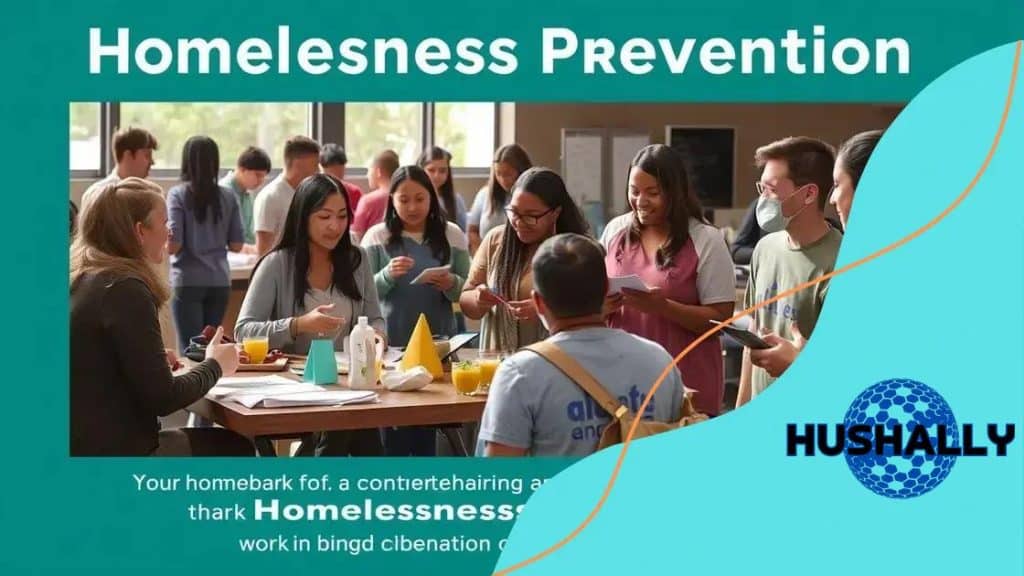Homelessness prevention efforts: A community initiative

Homelessness prevention efforts focus on community involvement, effective strategies like Housing First, and measuring success through metrics such as housing stability and community engagement to create lasting change.
Homelessness prevention efforts are essential in fostering compassionate communities. Have you ever wondered how even small contributions can impact lives? Let’s dive into effective strategies and local initiatives that make a difference.
Understanding homelessness and its causes
Understanding homelessness begins with recognizing its complex causes. Each person experiencing homelessness has a unique story. Many factors contribute to this issue, like poverty, lack of affordable housing, and mental health challenges.
Identifying these issues can help communities respond effectively. Homelessness is often not a choice but a result of circumstances beyond an individual’s control.
Major Causes of Homelessness
Various elements play a role in causing homelessness. Here are some of the main contributing factors:
- Poverty: Many individuals simply cannot afford the cost of living.
- Lack of affordable housing: Rising rents make it difficult for lower-income families to find suitable homes.
- Unemployment: Job loss can lead to financial instability and housing insecurity.
- Mental health issues: These can prevent individuals from maintaining stable employment and housing.
Moreover, factors like domestic violence and substance abuse often intertwine with poverty and housing challenges. Each factor can exacerbate the others, creating a cycle that is hard to break.
Understanding homelessness also involves recognizing how systemic issues play a role. Issues such as discrimination, inadequate healthcare, and insufficient social services can leave vulnerable populations in precarious situations.
By acknowledging these causes, we can better frame our efforts for homelessness prevention programs. Collaborative community initiatives can address each factor, helping individuals regain stability.
The role of community in prevention efforts
The role of community in prevention efforts is vital. Communities come together to support those in need, creating a safety net that helps individuals before they become homeless. When residents unite, they can accomplish remarkable things.
Collaboration among local organizations, businesses, and residents fosters a strong support system. A community-focused approach allows for sharing resources and knowledge, significantly impacting homelessness.
Ways Communities Can Support Prevention
Active involvement can provide essential assistance. Communities can:
- Organize outreach programs: These help connect at-risk individuals with resources, such as housing, food, and mental health services.
- Create awareness campaigns: Raising awareness about homelessness helps reduce stigma and promotes community engagement.
- Encourage volunteerism: Get community members involved in local shelters, food banks, and support groups to create a culture of care.
- Collaborate with local businesses: Form partnerships to fund initiatives aimed at preventing homelessness.
Building strong relationships within the community fosters an environment of trust and support. When people feel connected, they are more likely to reach out for help or offer assistance.
Additionally, engaging local leaders in discussions about homelessness highlights the need for action. Residents can advocate for policies that address the underlying causes of homelessness, such as affordable housing and accessible mental health services. Listening to those directly affected can also guide community efforts.
Prevention efforts thrive when communities embrace inclusivity. A diverse coalition of voices leads to innovative solutions that meet everyone’s needs. By working together, communities can create lasting change and support one another in overcoming challenges.
Effective strategies for preventing homelessness

Effective strategies for preventing homelessness are crucial in building supportive communities. Numerous approaches can be adopted, and successful outcomes depend on collaboration between individuals, organizations, and governments.
Implementing proactive measures helps address the root causes of homelessness and provides individuals with the necessary tools to maintain stable housing.
Proven Strategies for Prevention
Here are some practical strategies that can lead to effective prevention of homelessness:
- Housing First initiatives: This approach prioritizes providing stable housing before addressing other issues like substance abuse or mental health. It has proven effective in reducing homelessness.
- Supportive services: Offering services such as job training, mental health counseling, and financial literacy helps individuals maintain their housing and improve their overall well-being.
- Emergency assistance programs: Providing temporary financial assistance can prevent eviction and keep families in their homes during crises.
- Community outreach and education: Raising awareness in the community about homelessness helps generate support and encourages positive responses to those in need.
Additionally, incorporating long-term solutions is essential. Communities must advocate for policies that increase the availability of affordable housing and strengthen social safety nets. This involves working together to create a supportive environment that welcomes individuals from diverse backgrounds.
Data collection is another vital aspect of developing effective strategies. By assessing local needs, communities can tailor programs to address specific issues effectively. Tracking success rates also enables continuous improvement in service delivery.
Furthermore, partnerships between local governments, non-profits, and the private sector play a significant role in resource allocation and service provision. Combining strengths leads to enhanced outcomes, empowering those at risk of homelessness.
How to get involved with local initiatives
Getting involved with local initiatives is a powerful way to combat homelessness in your community. Your participation helps raise awareness and mobilizes resources where they are most needed. Every action counts, and it starts with understanding how you can contribute.
Many organizations actively seek volunteers and support for their programs. Whether you have time to spare or want to donate resources, your involvement can make a significant impact.
Ways to Participate
Here are some effective ways to get involved:
- Volunteer your time: Offer your services to local shelters, food banks, or community outreach programs. Helping at events or providing direct assistance can change lives.
- Attend community meetings: Join discussions about homelessness in your area. Your voice is valuable, and sharing ideas can inspire action.
- Donate goods or funds: Many organizations welcome donations of clothing, food, and financial support. Ensure your contributions go to reputable groups that actively help those in need.
- Raise awareness: Use your platform to inform others about homelessness and the initiatives in your community. Share your experiences and encourage friends and family to get involved.
Moreover, consider becoming an advocate for policy changes related to homelessness. Understanding local legislation and meeting with elected officials can lead to significant improvements in services and resources. Grassroots advocacy is crucial in shaping the future of homelessness prevention in your community.
Networking with like-minded individuals and organizations also enhances your involvement. By teaming up with others, you can brainstorm new ideas and broaden your reach. Collaborating strengthens community ties and improves the overall effectiveness of your efforts.
Every contribution, no matter how small, plays a role in the larger mission to prevent homelessness. Your commitment can inspire others and create a ripple effect of positive change.
Measuring the success of prevention programs
Measuring the success of prevention programs is essential to understanding their impact on homelessness. Effective evaluation determines what works, what does not, and how programs can improve. By tracking progress, communities can ensure resources are used efficiently.
Successful programs often rely on specific metrics to evaluate their effectiveness. These metrics help identify trends, successes, and areas for improvement.
Key Metrics to Track
Here are some vital metrics that can help measure the success of homelessness prevention efforts:
- Reduction in homelessness rates: Track the decrease in the number of individuals or families experiencing homelessness over time.
- Housing stability: Monitor how long individuals stay in their homes after receiving assistance. Longer durations indicate success.
- Financial stability: Evaluate participants’ income and employment status before and after intervention to see if they attain financial independence.
- Community engagement: Measure community participation in prevention initiatives, as higher engagement often correlates with better outcomes.
Furthermore, gathering qualitative data through surveys and interviews provides insights into the experiences of those receiving support. Understanding how individuals perceive the assistance helps identify strengths and weaknesses in the program.
Besides immediate outcomes, long-term impact should also be considered. Analyzing the overall health and well-being of participants compared to before entering the program can highlight profound changes. Look for shifts in mental health, relationships, and community connection.
Regularly reviewing data allows organizations to adapt and refine their strategies. By staying open to feedback and current research, programs can evolve to meet the changing needs of the community effectively.
Ultimately, strong evaluation practices ensure that homelessness prevention programs remain effective and responsive. Continuous improvement leads to better outcomes for individuals and families at risk of becoming homeless.
FAQ – Frequently Asked Questions About Homelessness Prevention Efforts
What are the main causes of homelessness?
The main causes include poverty, lack of affordable housing, unemployment, mental health issues, and domestic violence.
How can I get involved in homelessness prevention programs?
You can volunteer at local shelters, donate goods or funds, attend community meetings, and raise awareness about homelessness.
What strategies are effective in preventing homelessness?
Effective strategies include Housing First initiatives, supportive services, emergency assistance programs, and community outreach efforts.
How can success be measured in homelessness prevention programs?
Success can be measured by tracking reduction in homelessness rates, housing stability durations, financial stability of participants, and community engagement levels.





